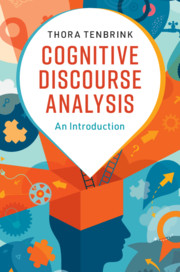Book contents
- Cognitive Discourse Analysis
- Cognitive Discourse Analysis
- Copyright page
- Contents
- Figures
- Tables
- Preface
- Acknowledgements
- Introduction
- 1 Background and Scope
- 2 Language as a Representation of Thought
- 3 Resources
- 4 Identifying Cognitive Orientation
- 5 Identifying Cognitive Depth
- 6 Identifying Cognitive Constructiveness
- 7 Using Language to Convey Thoughts
- 8 CODA Procedures
- 9 Beyond CODA
- Register of Linguistic Features
- References
- Index
4 - Identifying Cognitive Orientation
Published online by Cambridge University Press: 23 January 2020
- Cognitive Discourse Analysis
- Cognitive Discourse Analysis
- Copyright page
- Contents
- Figures
- Tables
- Preface
- Acknowledgements
- Introduction
- 1 Background and Scope
- 2 Language as a Representation of Thought
- 3 Resources
- 4 Identifying Cognitive Orientation
- 5 Identifying Cognitive Depth
- 6 Identifying Cognitive Constructiveness
- 7 Using Language to Convey Thoughts
- 8 CODA Procedures
- 9 Beyond CODA
- Register of Linguistic Features
- References
- Index
Summary
Chapter 4 is the first of four chapters that each explore conceptual aspects that are of potential interest to researchers when using language to access cognition, across a broad range of subject areas. These conceptual aspects can therefore be regarded as prominent analysis perspectives. This chapter starts by discussing two central phenomena related to cognitive orientation: attention and perspective. Both of these are systematically reflected in language use, albeit in different ways: attention underlies our choice of what we say, whereas perspective addresses how we say it. What we say will reflect what we attend to; aspects that we barely think about will rarely be reflected in our descriptions. As we formulate what we’re attending to, we can use our own point of view or adopt a different one, such as our interaction partner’s standpoint. While we don𣀙t often say explicitly which perspective we’re using, our language will reflect the underlying viewpoint in systematic ways.
Keywords
Information
- Type
- Chapter
- Information
- Cognitive Discourse AnalysisAn Introduction, pp. 92 - 116Publisher: Cambridge University PressPrint publication year: 2020
